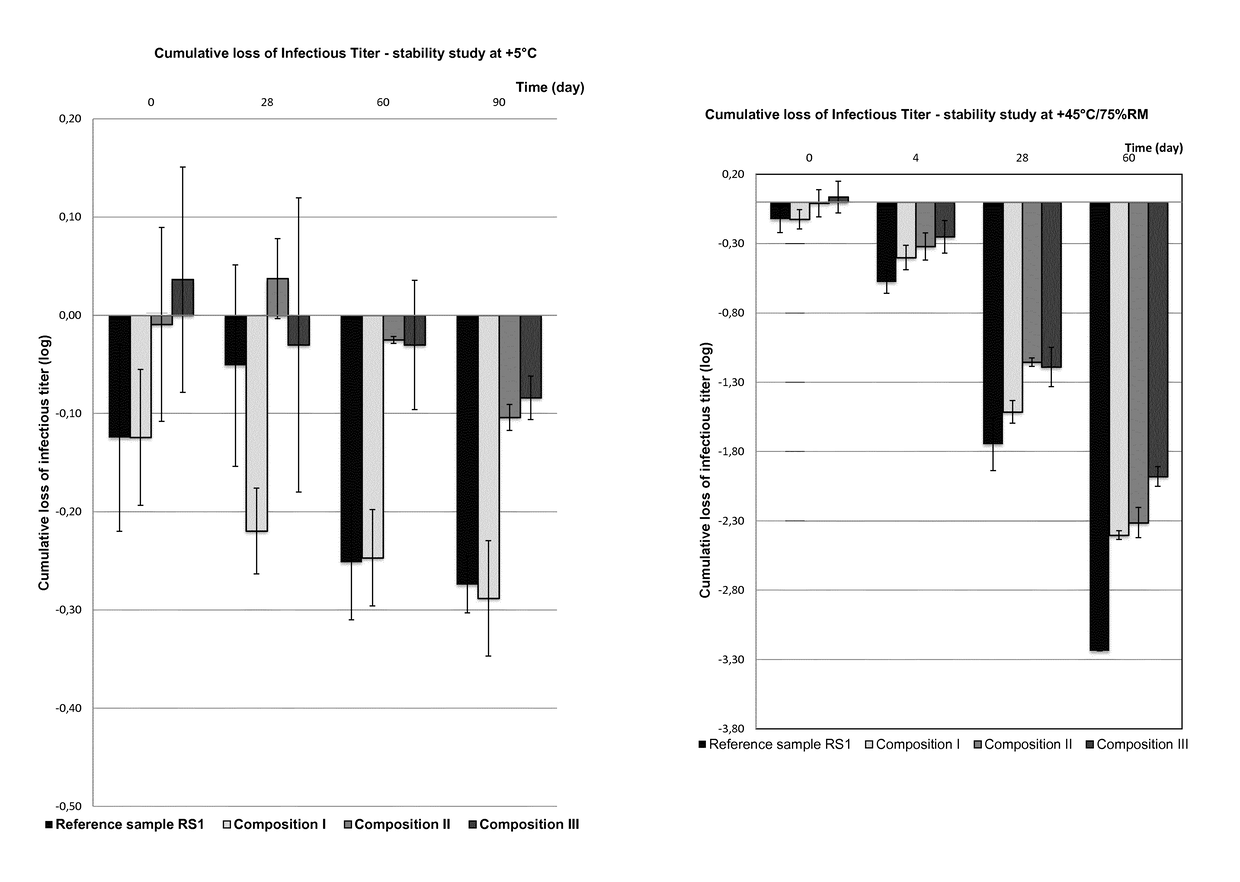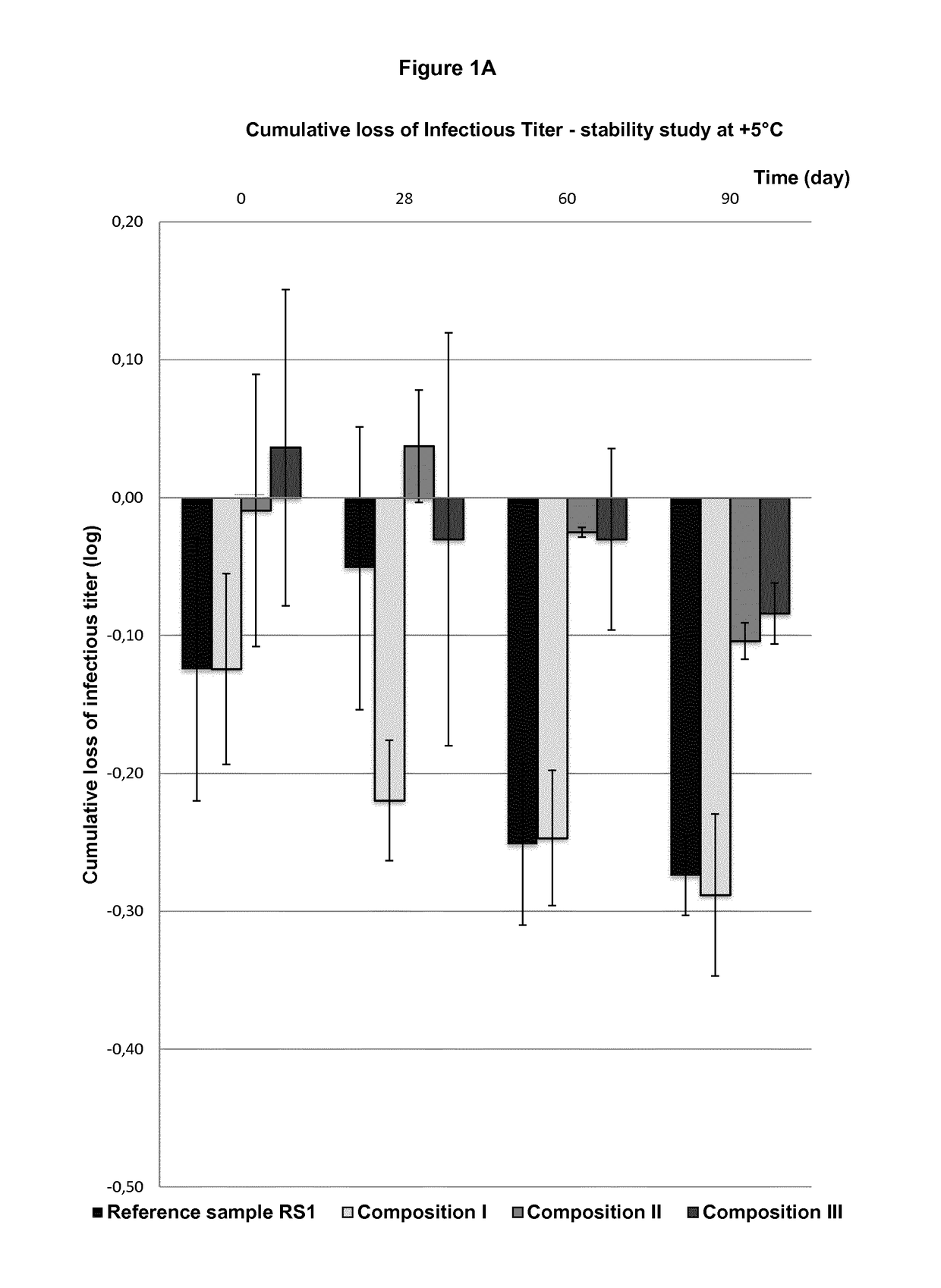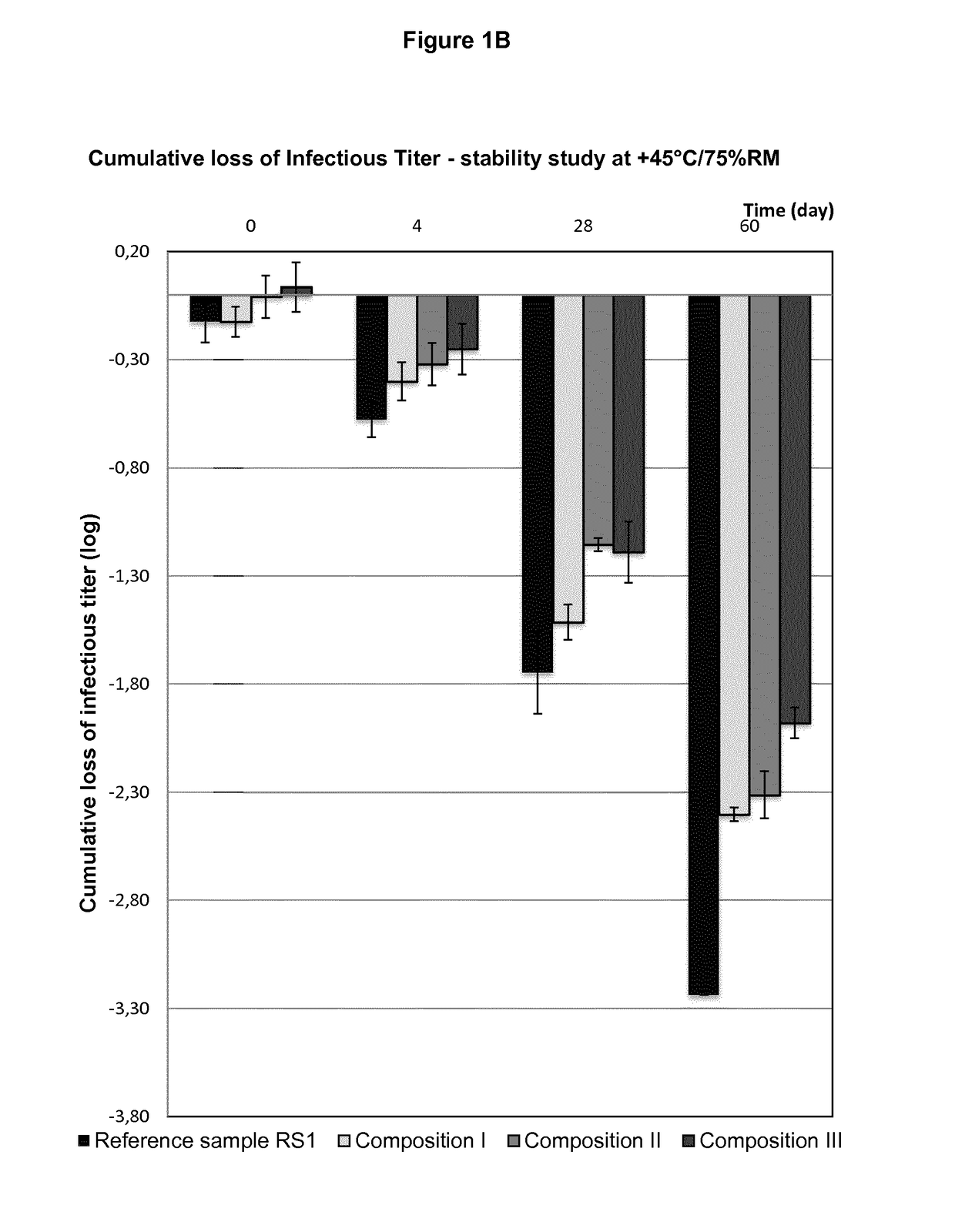Virus-containing formulation and use thereof
a technology of biological active materials and formulations, applied in the field of formulations can solve the problems of limiting the distribution of biological materials to developing nations with limited infrastructure, the storage and shipping of biologically active materials used, and the pharmaceutical industry is problematic, so as to shorten the stability evaluation of formulations
- Summary
- Abstract
- Description
- Claims
- Application Information
AI Technical Summary
Benefits of technology
Problems solved by technology
Method used
Image
Examples
example 1
on of Liquid Poxvirus-Containing Formulation to be Freeze-Dried
[0225]The hereinafter referenced liquid formulation I to V have been prepared according to the following steps. These formulations comprise MVA-based products. More precisely, formulations I to III comprise TG4001 and formulations IV and V comprise TG4040.
[0226]a) TG4001 and TG4040 were initially maintained in a frozen state in Solution A1 and Solution A2, respectively. The content of each solutions Aa (comprising TG4001) and A2 (comprising TG4040) is detailed in the following Table 1.
[0227]
TABLE 1Solution A1Solution A2(for preparing(for preparingformulationsformulationsI to III)IV and V)Virus titer (Pfu / mL)2.40E+083.20E+08Saccharose (%)55Monosodium10 mM10 mMGlutamateNaCl50 mM50 mMTRIS—10 mMNa2HPO4 / KH2PO410 mM—pH7.5 ±7.5 ±0.50.5Solutions A1 and A2 were thawed out.
[0228]If necessary, Solutions A1 and A2 can be further diluted according to methods well-known by the person skilled in the art. For instance, solution A1 was n...
example 2
on of Corresponding Freeze-Dried Formulations I to V
[0239]In the following examples, all lyophilizations were done in a Lyophilizer TELSTAR LYOBETA 25.
[0240]The lyophilization protocol was the following.
a) Preparation of Dry Products I to III
[0241]TopLyo® vials (SCHOTT™) were filled with liquid formulations I to III as previously obtained in example 1 and the lyophilization process was carried out as follows:
[0242]
Freezing stepPressionTemperatureRampStabilizationDescription(mbar)(° C.)(h:min)(h:min)LoadingAP (AtmosphericRTPressure)FreezingAP−452:000:30
[0243]
Primary drying stepPressionTemperatureRampStabilizationDescription(mbar)(° C.)(h:min)(h:min)Primary 10.1−100:15Primary 20.1−355:008:00
[0244]
Secondary drying stepPressionTemperatureRampStabilizationDescription(mbar)(° C.)(h:min)(h:min)Secondary drying 10.0047 mbar400:158:00Secondary drying 20.0047 mbar200:30
b) Preparation of Dry Products IV and V
[0245]TopLyo® vials (SCHOTT™) were filled with liquid formulations IV and V as previou...
example 3
Studies: Evaluation of Overall Virus Titer Losses, i.e. During Storage Overtime, Including Loss Due to Lyophilization Process
[0253]3.a) Reconstitution of Dry Products I to V
[0254]Reconstituted materials (Reconstit. Compo.) I to V prepared with WFI in a final volume of 680 μL just after lyophilization are detailed in the following Table 5 (i.e. without storage period for t0).
[0255]
TABLE 5Recon-Recon-Recon-Recon-Recon-stit.stit.stit.stit.stit.Compo.Compo.Compo.Compo.Compo.ComponentsIIIIllIVVViral vectorTG4001TG4001TG4001TG4040TG4040(PFU / mL)1.44E+081.21E+081.27E+082.07E+072.18E+07PVP 252525252525(g / L)Saccharose37.537.537.537.537.5(g / L)Monosodium1.91.91.91.91.9Glutamate(g / L)L-Arginine6.36.36.331.642.1(g / L)NaCl (g / L)2.92.92.92.91.5TRIS (g / L)———1.21.2Na2HPO40.601.192.390.140.14(g / L)KH2PO40.110.220.44——(g / L)pH7.5 ±7.5 ±7.5 ±7.5 ±7.5 ±0.50.50.50.50.5
[0256]In order to evaluate the virus titer of dry products I to V after the storage at either 5° C. or 45° C. for the indicated period of time,...
PUM
| Property | Measurement | Unit |
|---|---|---|
| molecular weight | aaaaa | aaaaa |
| molecular weight | aaaaa | aaaaa |
| temperature | aaaaa | aaaaa |
Abstract
Description
Claims
Application Information
 Login to View More
Login to View More - R&D
- Intellectual Property
- Life Sciences
- Materials
- Tech Scout
- Unparalleled Data Quality
- Higher Quality Content
- 60% Fewer Hallucinations
Browse by: Latest US Patents, China's latest patents, Technical Efficacy Thesaurus, Application Domain, Technology Topic, Popular Technical Reports.
© 2025 PatSnap. All rights reserved.Legal|Privacy policy|Modern Slavery Act Transparency Statement|Sitemap|About US| Contact US: help@patsnap.com



